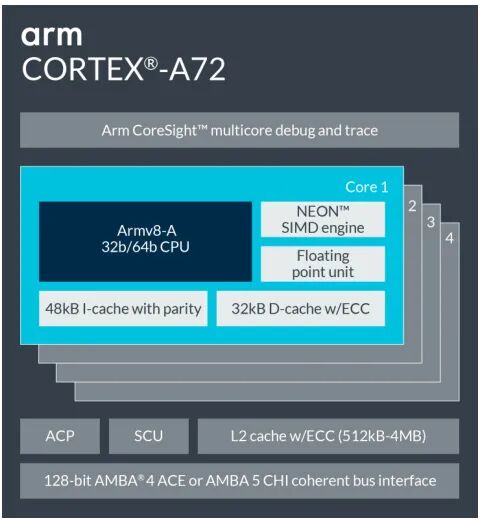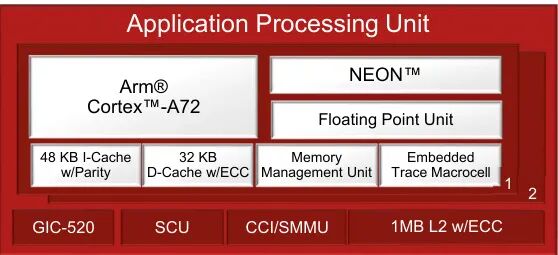The ARM Cortex-A72 is a high-performance 64-bit processor core based on the ARMv8-A architecture. Since its launch in 2015, it has been widely used in high-end mobile devices, embedded systems, automotive electronics, and consumer electronics.
1. Architecture and Performance Features
The Cortex-A72 adopts the ARMv8-A architecture, supporting 64-bit data processing, and introduces extended virtual address space and 64-bit general-purpose registers, significantly enhancing the processor’s performance and flexibility. Its core design is a superscalar processor, featuring a 3-issue superscalar design and a 15-stage pipeline to improve instruction throughput and execution efficiency.
- Core ConfigurationThe Cortex-A72 supports 1 to 4 cores, with each core equipped with 48KB L1 instruction cache (with parity) and 32KB L1 data cache (with ECC protection), along with 1MB L2 cache (with ECC protection), to enhance data access efficiency and reliability.


- Memory SubsystemThe Cortex-A72 supports AMBA 4 ACE or AMBA 5 CHI coherent bus interfaces, and integrates NEON SIMD engine and single-precision/double-precision floating-point units to accelerate multimedia and scientific computing tasks.

- Power Consumption and EfficiencyCompared to the previous generation Cortex-A57, the Cortex-A72 offers approximately 1.8 times the performance at the same process node, while reducing power consumption by 20%. At 16nm process technology, its power consumption is further reduced by 75%.
- Process TechnologyThe Cortex-A72 typically uses 14nm/16nm FinFET technology to achieve a balance between high performance and low power consumption.
- Extended FeaturesThe Cortex-A72 supports LPAE (Large Physical Address Extension), allowing for larger memory address space, suitable for applications with high memory requirements.
- Debugging and TracingThe Cortex-A72 integrates Embedded Trace Macrocell (ETM) and CoreSight Debug Interface (CTI), supporting the Arm CoreSight architecture, facilitating system-level debugging and performance analysis.
2. Application Scenarios
The high performance and low power characteristics of the Cortex-A72 make it an ideal choice for various high-end applications:
- High-end Mobile Devices such as flagship smartphones (e.g., Huawei Kirin 950, MediaTek MT6797) and large-screen mobile devices, used for running complex applications and multitasking.
- 5G Base Stations and Communication DevicesThe Cortex-A72 excels in 5G base station signal processing, supporting high bandwidth and low latency communication needs.
- Automotive ElectronicsThe Cortex-A72 is used in in-vehicle infotainment systems, Advanced Driver Assistance Systems (ADAS), and in-vehicle computing platforms, providing powerful computing capabilities and real-time responsiveness.
- Industrial Automation and Embedded SystemsThe Cortex-A72 is widely used in industrial automation, smart control, and embedded systems, supporting multitasking and real-time control.
- Consumer Electronics such as high-end smart TVs, digital TVs, and smart speakers, leveraging the high performance and low power characteristics of the Cortex-A72 to provide a smooth user experience.
3. Typical Chip Solutions
The Cortex-A72 is integrated into various SoCs and development boards to meet the needs of different application scenarios:
- RK3576J launched by Rockchip, featuring Cortex-A72 cores, suitable for smart terminals and edge computing devices.
- NXP LS2088ANXP’s Layerscape series processors, integrating dual-core Cortex-A72, supporting 1.3GHz frequency, suitable for industrial and automotive electronics applications.
- Huawei Kirin 950 featuring quad-core Cortex-A72, with a frequency of 2.5GHz, used in high-end smartphones, providing strong performance and efficiency.
- Raspberry Pi 4B featuring quad-core Cortex-A72, with a frequency of 1.5GHz, suitable for education, development, and embedded systems.
- i.MX 8 SeriesNXP’s i.MX 8 series application processors, integrating dual-core Cortex-A72 and dual GPUs, suitable for automotive electronics, industrial automation, and human-machine interfaces (HMI).
4. Operating System and Software Support
The Cortex-A72 supports various operating systems and development environments:
- LinuxThe Cortex-A72 is highly compatible with the Linux kernel, suitable for embedded systems and server applications.
- AndroidThe Cortex-A72 is suitable for Android smartphones and tablets, providing a smooth user experience.
- Real-Time Operating Systems (RTOS) The Cortex-A72 supports real-time operating systems such as Xenomai, QNX, and VxWorks, suitable for industrial control and automotive electronics.
- Development ToolsThe Cortex-A72 provides a rich development toolchain, including Arm Compiler, Debugger, Trace Tool, and System Workbench for Linux, facilitating system-level debugging and optimization for developers.
5. Comparison with Other Processors
The Cortex-A72 has significant advantages in performance and power consumption:
- Compared to Cortex-A57The Cortex-A72 offers approximately 1.8 times the performance while reducing power consumption by 20%. At 16nm process technology, its power consumption is further reduced by 75%.
- Compared to Cortex-A53The Cortex-A72 shows about 30% improvement in single-core performance over the Cortex-A53, and also demonstrates stronger competitiveness in multi-core performance.
- Compared to Intel AtomIn the Geekbench 4 tests, the Cortex-A72 achieved higher scores in both single-core and multi-core tests, indicating greater efficiency in handling the same tasks.
- Compared to Apple A Series ProcessorsThe Cortex-A72 has advantages in power management, especially suitable for power-sensitive application scenarios such as mobile devices and embedded systems.
6. Design and Development Recommendations
To fully leverage the performance of the Cortex-A72, designers should pay attention to the following points:
- Thermal DesignDue to the high performance of the Cortex-A72, good thermal solutions should be considered in the design to avoid overheating.
- Power ManagementUtilize Dynamic Voltage Frequency Scaling (DVFS) technology to optimize power consumption and performance.
- Cache OptimizationReasonably configure L1 and L2 caches to improve data access efficiency and system performance.
- Multi-Core SchedulingIn multi-core systems, tasks should be allocated reasonably to fully utilize multi-core advantages.
7. Future Outlook
Although the Cortex-A72 has been succeeded by later processors such as Cortex-A73/A75, it still holds a certain competitive edge in the mid-to-high-end market. With the development of emerging technologies such as AI, 5G communication, and the Internet of Things, the performance and energy efficiency advantages of the Cortex-A72 will continue to support its role in high-performance computing and edge computing fields.